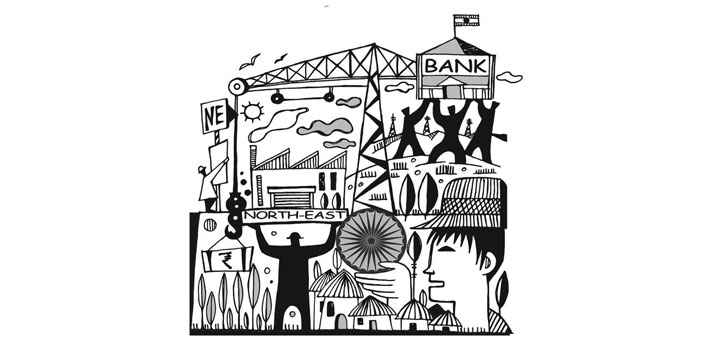The Northeast India is a region of eight states – Arunachal Pradesh, Assam, Manipur, Meghalaya, Mizoram, Nagaland, Sikkim and Tripura – and is India’s most distinct and spectacular region. Ranging between eastern India and eastward extension of the Himalayas, the earlier ‘Seven Sisters’ are now known as ‘Seven Sisters and One Brother’ after the inclusion of Sikkim.
A land of unmatched beauty and potential
Mention of Northeast India can be traced way back to 100 BC by the Chinese explorer, Chang Kien. Throughout its history and till today, this region is known to have been an important physical and cultural link between India, East Asia and Southeast Asia. Physical geography of the region can be categorised into the Eastern Himalayas, Patkai-Naga Hills, Lushai Hills, the Brahmaputra Valley and the Barak Valley plains. The region endowed with huge untapped natural resources, covered with dense forests, has the highest rainfall in the country, with large and small river systems, and it is a treasure house of flora and fauna. For those who haven’t been to the Northeast, it has enchanting natural beauty, still largely undiscovered. Over 220 ethnic groups and an equal number of dialects make the region hugely diverse. Marked by diversity in customs, culture, traditions and languages, it is home to multiple social, ethnic and linguistic groups. Each of the Northeast states has its own unique history – of formation, of its ethnic people, tradition and culture.
However, for the people of the Northeastern states, the region is homogenous in terms of celebration of festivals, artworks and food habits. Each of these carries with it a rich colour and aroma of heritage and legacy. If we compare the Mopin, Solung and Lossar of Arunachal Pradesh with the colourful and vibrant Bihu of Assam, we find the roots of agriculture and association with the ritualistic gaiety either to thank God or to pray for bumper harvest, very similar. Likewise, the Sattriya dance from Assam can be correlated with the Lai Haraoba festival of Manipur.
Bamboo, cane and wood are widely used in all the Northeastern states for making various handicraft items which are widely recognised now. The food in the region is mostly about meat, and owes its taste to the hilly region influence.While some of these dishes are being served in various restaurants of the country, the richness of this cuisine is yet to be explored.
Challenges and opportunities
However, the general lack of understanding of the Northeast by mainland India is a matter of concern. Due to negative publicity, there is a misconception that the Northeast is a disturbed land of militancy, ethnic violence, and so on. In contrast, there is a lot scope in the Northeast for tourism, Information Technology, fashion, music and food industry.
Traditionally, Northeast India has been neglected by successive governments in Delhi, resulting in alienation. However, in the last decades, emphasis on the development of the region has been given priority. Prime Minister (PM) Narendra Modi, after taking over, has placed strong emphasis on the development of this region. The region needs to be developed economically, since it has unmatched potential and resources to be the most prosperous region of the country. As of now, there are enough challenges, such as:
- Connectivity issues – Northeast is connected by just a 22km corridor to mainland India.
- Very poor infrastructure – Road, waterways etc., need huge improvement
- Law and order situation needs attention
- Lack of skilled manpower
- Very poor governance
However, Northeast offers plenty of opportunities too:
- It is the gateway to ASEAN (Association of Southeast Asian Nations) countries, one of the richest areas in the world.
- It has unmatched potential for tourism.
- It has oil and gas, forest resources, and around 60000 MW of hydropower potential
- It has the largest river in India
- English speaking manpower
India’s “Look East Policy” and the Northeast
India’s Look East Policy (LEP) aims at integrating India with the emerging economies of Southeast Asia. The ASEAN block comprises 10 countries with an economy of 2.3 trillion USD, and is the third largest economy after China and India. It has a sustained growth rate of 6% per annum for the last 15 years. India’s bilateral trade with ASEAN countries including China, Nepal, Bhutan and Bangladesh was estimated at 152 billion USD in 2013-14, which could cross 1000 billion USD by 2035. These are huge numbers, which could change the entire face of India’s economy.
Northeast India, having 98% boundary with the Southeast Asian neighbours, is critical to make this dream possible. The region shares international boundary with China in the North, Myanmar in the East, Bangladesh in the South West and Bhutan in North West. Northeast may just have a 22 km corridor link to Mainland India, but it has a 4,500 km boundary with Southeast Asian countries!
Implementing India’s LEP could covert the present geographical isolation of Northeast into a huge economic opportunity. The region as a whole has a strong historic relationship with Southeast Asia. It is a historical reality that Chao Lung Siu Ka Phawas, a great king and son of king Phuchangkhang from Maulung in Western Yunan Province of South China, migrated to Assam in 1228 AD with 9000 men, women, animals, and set up the Ahom Kingdom in Assam, which ruled Assam for a period of 600 years. Many such instances are available in various other parts of Northeast India.
At present, India’s trade with Nepal, Bhutan, Bangladesh, Cambodia, Laos PDR, Myanmar, Thailand and Vietnam has grown from `81,385 crore in 2009-10 to Rs. 184,687 crore in 2013-14 with the Northeast share of this trade being only 1-2%. Exports from India to Myanmar, Bhutan and Bangladesh amount to Rs 7310 crore, which could be even more significant if it could be made from Northeast.
Bangladesh is very critical for the future growth of Northeast. Over 15% of Bangladesh’s imports come from India. Bangaldesh’s exports to India receive tariff concessions under SAFTA (South Asian Free Trade Area), though illegal
trade between the two countries amounts to two-third of the regular trade! Tripura, Meghalaya, Mizoram and Assam share a 1,880 km long border with Bangladesh, which needs the Northeast markets to sell its products. Bangaldesh’s waterways are critical for Northeast to provide an exit route from its landlocked markets.
Pre-independence undivided Assam was the fifth largest economy of India. Chittagong Port, presently in Bangladesh, was a major port of shipment which was used to transport coal, oil, tea, timber etc. However, post independence Northeast India lost its connectivity and started going down economically. Similarly, Myanmar has huge oil and gas potential which could be exploited, and substantial investment could be made in the Northeast.
Key projects under India’s LEP
Connectivity through Myanmar could dramatically change the outlook of the Northeast Region (NER), from that of a landlocked region to a veritable gateway to one of the most dynamic economic regions of the world.
The 1,360 km ‘Trilateral Highway’ is the most critical project of India’ LEP, vis-a-vis Northeast. The road will connect Moreh in Manipur to Mae Sot in Thailand. The route envisaged is Moreh (India) – Tamu – Kalewa – Yagyi – Monywa – Mandalay – Meiktila – Nay Pyi Taw – Payagyi – Theinzayat – Thaton – Hpa’an – Kawkareik – Myawaddy (Myanmar) – Mae Sot (Thailand).
Work is currently underway on upgrading the Tamu- Kalemyo sector of the India-Myanmar-Thailand Trilateral Highway; after that, the sector between Kalewa and Yargyi will be taken up, while Myanmar itself, and perhaps other foreign partners will take up the rest of the highway, which will enter Thailand at Mae Sot, with other roads leading to Laos. It is expected that the Trilateral Highway will be operational by 2018. The project is taking very long to finish due to various issues including problems with land acquisition, insurgency etc. The implementation of this project would be crucial for the operationalisation of the policy.
The ‘Kaladan Mutli-Modal Transit Transport Project’ when implemented, will connect Kolkata to Sittwe Port in Myanmar, and then further to Mizoram by river and road. This project would open up the land-locked Northeast India to the sea port of Sittwe, and is expected to provide a huge boost for manufacturing and trade. This will open up a new transport route for the entire NER in general, and Mizoram in particular. The road segment of the project has not kept to schedule, but it will undoubtedly progress along with the Kaladan Waterway Component, which should be completed by this year. As the hydrocarbon potential of the NER is developed, the port of Sittwe and the infrastructure developed for the Kaladan Transport Project might have a useful role to play, as part of an energy corridor. As economic growth and transport linkages are enhanced, it may become practical to review the feasibility of tapping the hydro-power potential of northern Myanmar, and building energy grids into India.
Cultural exchanges and the way forward
The strongest element of our “Look East” engagement would be that which brings our people together. Professionals, entrepreneurs, students, tourists, and others can travel and engage more extensively across our region. India’s intellectual and scientific links with the countries to its East will be of increasing significance in the future.
Northeast India is a very sensitive place. Inhabited by myriad tribes with lesser connect with mainland India, it is very important to understand the sensibilities of the area. India’s LEP should be implemented with consultation with
the people of the region. Most important, we will have to ensure that Northeast India gets benefits of the policy, in real terms, rather than being just a transit point.
India’s LEP is under discussion/implementation since early 2000. However, not many projects have been implemented on the ground. There are issues like land acquisition, international protocol issues, insurgency etc., which have hampered progress. Also, the effort on the part of India hasn’t been upto expectation, which is viewed cynically by people of the Northeast.
The new Prime Minister has raised a new slogan; instead of “Look East”, he says it’s time for “Act East”. We are confident there would be a renewed thrust on the implementation of key projects like the ‘Trilateral Highway’, ‘Kaladan Multi-modal Project’ etc., which would ensure the LEP happening in real terms. It would change the country and most importantly, these projects will change the entire landscape of Northeast India.


